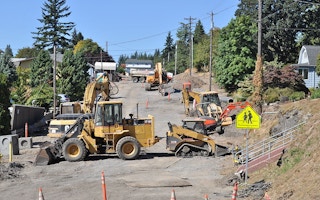Roads can be arteries that ferry goods and people, connect communities and markets and bolster economic development.
But if they’re not well-planned, they can instigate conflict, saddle countries with debt and open the door to environmental destruction, according to a new study published Monday.
Globally, some 25 million kilometers (15.5 million miles) of paved roads are set to be built in the next three-and-a-half decades. Yet, until now, there have been few studies on the economic, social and environmental risks of roads.
“None of the research is completely focused on integrating all three of these sectors,” said Mohammed Alamgir, an environmental scientist at James Cook University in Cairns and the lead author of the new study.
“
We are not saying that you can’t build a road. The issue is where can you build the road for the greatest economic outcome.
Mohammed Alamgir, environmental scientist, James Cook University
He and his colleagues pulled together the available research on the effects of road building and uncovered a disconcerting pattern. They reported their findings in the journal Current Biology.
“There’s this kind of insidious dynamic of systematically overestimating the benefits and underestimating the costs,” said William Laurance, a tropical ecologist at James Cook and one of the paper’s authors, in an interview.
The impacts of a road tend to ripple through an ecosystem. As people move in, they mine the earth, hunt wildlife and cut down trees, potentially destroying habitat, decimating species and affecting important ecosystem services like the provision of clean water.
Laurance led a team in 2014 that discovered that nearly 95 percent of deforestation in the Brazilian Amazon takes place within 5.5 kilometers (3.4 miles) of roads or 1 kilometer (0.6 miles) of rivers. But the public debate often justifies these environmental risks with the progress that is assumed will follow.
For example, planners often don’t account for the long-term costs that come with road construction. Laurance and his team found that maintenance costs could amount to 10 to 20 percent per year of the initial price tag for the road, quickly swamping any economic benefits with unanticipated costs.
Maintaining roads is particularly tough — and expensive — in tropical rainforests, where big swings in seasonal water levels and deluges of rain test the strength of a road’s construction.
The authors point out that planned roadways through wet tropical forests, such as the Trans Papua Highway in Indonesian New Guinea and Malaysia’s Pan Borneo Highway, face the challenge of cutting through steep terrain. That heightens the risks of flooding, mudslides and slumping of the road, all of which would be costly to repair.
Corruption and a lack of transparency during the construction process also drive up the price of many road projects. One study demonstrated that nearly a quarter of the costs from a set of 600 road construction projects in Indonesia “could not be explained.”
Tropical ecologist Fritz Kleinschroth, who was not involved in the research, studies the impacts of roads in Central Africa. He called this paper a “useful overview of the risks of road projects in the tropics” and agreed that looking at the entire lifespan of a road is something that most planners just don’t do.
“Very often, there’s a big investment coming in, and they build a beautiful new road across a deserted landscape,” Kleinschroth said in an interview. “But no one takes care of the maintenance. Give it 10 or 20 years, and the road will not be usable anymore.”
In cases where maintenance does happen, the country’s citizens typically end up footing the bill.
“A lot of this ends up as public debt,” Kleinschroth said. While a few people might benefit at the outset of these projects, “The general population is losing, short-term and long-term,” he added.
The province of Aceh in Indonesia has had to come up with $15 million annually to protect communities against floods that have resulted from the deforestation that accompanied road building there, according to a study that the team cites.
“One of the points we’re trying to make is just cold, hard economics,” Laurance said. While they seem like they would be profitable, he added, “You really quickly realize they’re not.”
At the same time, he and his colleagues know that, in many places, a lack of good roads can keep people under the yoke of poverty.
“These are nations that need to develop,” Laurance said. The resulting “narrative” around road building is often about “fast-tracking” projects and “accelerating” growth.
But by creating a more deliberate process and pinpointing the best locations, the team argues that the roads that will be built are more likely to benefit the public.
“Definitely, one approach in our research has to be very clear,” Alamgir said. “We are not anti-development.”
Kleinschroth echoed the importance of differentiating between risky and beneficial roads. “Rather than fighting all roads in the world, we should focus on the ones that have the most detrimental effects,” he said.
To encourage what Laurance’s team calls “smart development,” they make their data available online through a project called Global Road Map.
There, they’ve identified the places where roads would help boost the economy but drive the least amount of environmental damage, resulting in maps showing the most promising — and the most potentially destructive — spots for road construction on Earth. They are also sharing their message with officials, conservationists and other scientists across Southeast Asia and equatorial Africa.
“We are not saying that you can’t build a road,” Alamgir added. “The issue is … where can you build the road for the greatest economic outcome.”
This story was published with permission from Mongabay.com. Read the full story.










